
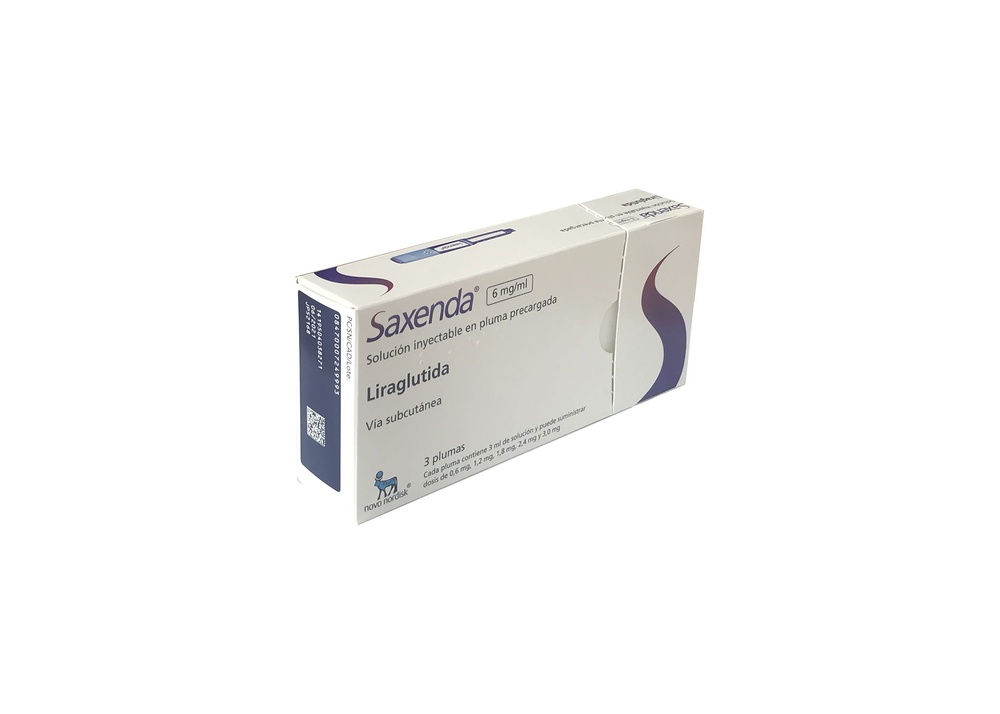
САКСЕНДА 6 мг/мл раствор для инъекций в предварительно заполненной ручке-шприце

Спросите врача о рецепте на САКСЕНДА 6 мг/мл раствор для инъекций в предварительно заполненной ручке-шприце

Инструкция по применению САКСЕНДА 6 мг/мл раствор для инъекций в предварительно заполненной ручке-шприце
Введение
Прошпект: информация для пациента
Саксенда 6мг/мл раствор для инъекций в предварительно заполненном шприце
лираглутид
Прочитайте внимательно весь прошпект перед началом использования этого лекарства, поскольку он содержит важную информацию для вас.
- Сохраните этот прошпект, поскольку вам может потребоваться прочитать его снова.
- Если у вас есть какие-либо вопросы, проконсультируйтесь с вашим врачом, фармацевтом или медсестрой.
- Это лекарство было назначено только вам, и не передавайте его другим людям, даже если у них такие же симптомы, как у вас, поскольку оно может нанести им вред.
- Если вы испытываете побочные эффекты, проконсультируйтесь с вашим врачом, фармацевтом или медсестрой, даже если это побочные эффекты, которые не указаны в этом прошпекте. См. раздел 4.
Содержание прошпекта
- Что такое Саксенда и для чего она используется
- Что вам нужно знать перед началом использования Саксенды
- Как использовать Саксенду
- Возможные побочные эффекты
- Хранение Саксенды
- Содержание упаковки и дополнительная информация
1. Что такое Саксенда и для чего она используется
Что такое Саксенда
Саксенда - это лекарство для похудения, содержащее активное вещество лираглутид. Она похожа на натуральный гормон, называемый пептидом-1, подобным глюкагону (GLP-1), который выделяется в кишечнике после еды. Саксенда действует на рецепторы мозга, контролирующие аппетит, и помогает вам чувствовать себя более сытым и менее голодным. Таким образом, она может помочь вам есть меньше и снижать вес.
Для чего используется Саксенда
Саксенда используется для похудения в сочетании с правильной диетой и физическими упражнениями у взрослых старше 18 лет с
- индексом массы тела (ИМТ) 30 кг/м2 или выше (ожирение) или
- ИМТ 27 кг/м2 и до менее 30 кг/м2 (избыточный вес) и проблемами со здоровьем, связанными с весом (такими как диабет, высокое кровяное давление, аномальные уровни жиров в крови или проблемы с дыханием во время сна, называемые "обструктивным апноэ во сне").
ИМТ - это мера веса в отношении роста.
Вы должны продолжать использовать Саксенду только если вы потеряли хотя бы 5% от вашего первоначального веса после 12 недель лечения с суточной дозой 3,0 мг (см. раздел 3). Проконсультируйтесь с вашим врачом перед продолжением.
Саксенда может быть использована в сочетании с здоровым питанием и увеличением физической активности для контроля веса у подростков от 12 лет и старше с:
- ожирением (диагностированным вашим врачом)
- весом тела более 60 кг
Вы должны продолжать использовать Саксенду только если вы потеряли хотя бы 4% от вашего ИМТ после 12 недель лечения с дозой 3,0 мг/день или максимально терпимой дозой (см. раздел 3). Проконсультируйтесь с вашим врачом перед продолжением.
Саксенда показана в сочетании с здоровым питанием и увеличением физической активности для контроля веса у пациентов от 6 до менее 12 лет с
- ожирением (диагностированным вашим врачом)
- весом тела ≥45 кг
Вы должны продолжать использовать Саксенду только если вы потеряли хотя бы 4% от вашего ИМТ после 12 недель лечения с дозой 3,0 мг/день или максимально терпимой дозой (см. раздел 3). Проконсультируйтесь с вашим врачом перед продолжением.
Диета и упражнения
Ваш врач назначит вам диету и программу упражнений, которые вы должны выполнять во время лечения Саксендой.
2. Что вам нужно знать перед началом использования Саксенды
Не используйте Саксенду
- если вы аллергичны к лираглутиду или любому другому компоненту этого лекарства (указанному в разделе 6).
Предостережения и меры предосторожности
Проконсультируйтесь с вашим врачом, фармацевтом или медсестрой перед началом использования Саксенды.
Использование Саксенды не рекомендуется если у вас тяжелая сердечная недостаточность.
Есть мало опыта использования этого лекарства у пациентов старше 75 лет. Не рекомендуется если вам 75 лет или более.
Есть мало опыта использования этого лекарства у пациентов с проблемами почек. Если у вас есть заболевание почек или вы находитесь на диализе, проконсультируйтесь с вашим врачом.
Есть мало опыта использования этого лекарства у пациентов с проблемами печени. Если у вас есть проблемы с печенью, проконсультируйтесь с вашим врачом.
Не рекомендуется это лекарство если у вас есть тяжелая проблема с желудком или кишечником, которая приводит к задержке опорожнения желудка (называемой гастропарезом), или если у вас есть воспалительное заболевание кишечника.
Если вы знаете, что будете подвергаться хирургической операции под анестезией (состояние сна), сообщите вашему врачу, что вы принимаете Саксенду.
Пациенты с диабетом
Если вы диабетик, не используйте Саксенду как замену инсулина.
Воспаление поджелудочной железы
Проконсультируйтесь с вашим врачом, если у вас есть или было заболевание поджелудочной железы.
Воспаление желчного пузыря и желчные камни
Если вы теряете много веса, вы рискуете desarrollать желчные камни и, как следствие, воспаление желчного пузыря. Прекратите использовать Саксенду и немедленно обратитесь к вашему врачу, если вы испытываете сильную боль в верхней части живота, обычно хуже на правой стороне, под ребрами. Боль может чувствоваться до спины или правого плеча. См. раздел 4.
Заболевание щитовидной железы
Проконсультируйтесь с вашим врачом, если у вас есть заболевание щитовидной железы, включая узлы щитовидной железы и увеличение щитовидной железы.
Частота сердечных сокращений
Проконсультируйтесь с вашим врачом, если у вас есть сердечные сокращения (вы осознаете удары сердца) или если у вас есть чувство ускорения пульса в состоянии покоя во время лечения Саксендой.
Потеря жидкости и обезвоживание
При начале лечения Саксендой возможно, что вы потеряете жидкость или обезвожитесь. Это может быть вызвано появлением тошноты, рвоты и диареи. Важно избегать обезвоживания, выпивая много жидкости. Если у вас есть какие-либо вопросы или сомнения, проконсультируйтесь с вашим врачом, фармацевтом или медсестрой. См. раздел 4.
Дети
Не было изучено безопасность и эффективность Саксенды у детей младше 6 лет.
Другие лекарства и Саксенда
Сообщите вашему врачу, фармацевту или медсестре, если вы используете, недавно использовали или можете использовать любое другое лекарство.
В частности, сообщите вашему врачу, фармацевту или медсестре, если:
- вы принимаете лекарства от диабета, называемые "сульфонилмочевинами" (такие как глимепирид или глибенкламид) или если вы получаете инсулин. Ваш уровень сахара в крови может снизиться (гипогликемия) если вы используете эти лекарства с Саксендой. Ваш врач может скорректировать дозу вашего лекарства от диабета, чтобы вы не испытывали эпизоды гипогликемии. См. раздел 4 для ознакомления с симптомами предупреждения о снижении уровня сахара в крови. Если вы корректируете дозу инсулина, ваш врач может порекомендовать вам чаще проверять уровень сахара в крови.
- вы принимаете варфарин или другие пероральные лекарства, снижающие свертываемость крови (антикоагулянты). Может потребоваться более частый анализ крови для определения способности крови к свертыванию.
Беременность и лактация
Не используйте Саксенду, если вы беременны, думаете, что можете быть беременной или планируете стать беременной, поскольку не известно, может ли Саксенда повлиять на плод.
Если вы используете Саксенду, вам следует избегать кормления грудью, поскольку не известно, выделяется ли Саксенда в грудное молоко.
Вождение и использование машин
Маловероятно, что Саксенда повлияет на вашу способность управлять транспортными средствами и использовать машины.
Некоторые пациенты могут испытывать головокружение при приеме Саксенды, особенно в течение первых 3 месяцев лечения (см. раздел "Возможные побочные эффекты"). Если вы испытываете головокружение, будьте очень осторожны при вождении или использовании машин. Если вам нужна дополнительная информация, проконсультируйтесь с вашим врачом.
Важная информация о некоторых компонентах Саксенды
Это лекарство содержит менее 1 ммоль натрия (23 мг) на дозу; это означает, что оно практически "не содержит натрия".
3. Как использовать Саксенду
Следуйте точно инструкциям по применению этого лекарства, указанным вашим врачом. В случае сомнений проконсультируйтесь с вашим врачом, фармацевтом или медсестрой.
Ваш врач назначит вам диету и программу упражнений, которые вы должны выполнять во время лечения Саксендой.
Сколько инъекций
Взрослые
Лечение начинается с низкой дозы, которая постепенно увеличивается в течение первых 5 недель лечения.
- Когда вы начинаете использовать Саксенду, начальная доза составляет 0,6 мг один раз в день в течение至少 одной недели.
- Ваш врач порекомендует вам постепенно увеличить дозу, обычно на 0,6 мг каждую неделю, до достижения рекомендуемой дозы 3,0 мг один раз в день.
Ваш врач порекомендует вам количество Саксенды, которое вы должны использовать каждую неделю. Обычно он порекомендует вам следовать следующей таблице.
Неделя | Инъекционная доза |
Неделя 1 | 0,6 мг один раз в день |
Неделя 2 | 1,2 мг один раз в день |
Неделя 3 | 1,8 мг один раз в день |
Неделя 4 | 2,4 мг один раз в день |
Неделя 5 и далее | 3,0 мг один раз в день |
Как только вы достигнете рекомендуемой дозы 3,0 мг на 5-й неделе лечения, продолжайте использовать эту дозу до окончания периода лечения. Не увеличивайте дозу еще больше.
Ваш врач будет периодически оценивать лечение.
Дети и подростки (6-18 лет)
Для детей и подростков от 6 лет до менее 18 лет следует следовать постепенному увеличению дозы, как и для взрослых (см. выше таблицу для взрослых). Дозу следует увеличить до 3,0 мг (дозы поддержания) или до максимально терпимой дозы. Не рекомендуется суточная доза более 3,0 мг.
Как и когда использовать Саксенду
- Прежде чем использовать шприц впервые, ваш врач или медсестра покажет вам, как его использовать.
- Вы можете использовать Саксенду в любое время дня, с или без еды и напитков.
- Используйте Саксенду примерно в одно и то же время каждый день: выберите время, которое вам больше всего подходит.
Где инъекцию
Саксенда вводится как подкожная инъекция.
- Лучшие места для инъекции - это область живота, передняя часть бедра или верхняя часть руки.
- Меняйте место инъекции каждый день, чтобы снизить риск развития уплотнений на коже.
- Не вводите в вену или мышцу.
На другой стороне этого прошпекта вы найдете подробные инструкции по использованию.
Пациенты с диабетом
Сообщите вашему врачу, если у вас диабет. Ваш врач может скорректировать дозу вашего лекарства от диабета, чтобы вы не испытывали эпизоды гипогликемии.
- Не смешивайте Саксенду с другими инъекционными лекарствами (например, инсулинами).
- Не используйте Саксенду в сочетании с другими лекарствами, содержащими агонисты рецептора GLP-1 (такие как эксенатид или ликсенатид).
Если вы используете больше Саксенды, чем должны
Если вы используете больше Саксенды, чем должны, поговорите с врачом или немедленно обратитесь в больницу. Возьмите с собой упаковку лекарства. Вам может потребоваться медицинское лечение. Могут возникнуть следующие эффекты:
- тошнота
- рвота
- низкий уровень сахара в крови (гипогликемия). См. симптомы предупреждения о снижении уровня сахара в крови в "Частых побочных эффектах".
Если вы забыли использовать Саксенду
- Если вы забыли дозу и вспомнили об этом в течение 12 часов после того, как обычно вводите дозу, введите ее как можно скорее.
- Однако, если прошло более 12 часов после того, как вы должны были использовать Саксенду, пропустите забытую дозу и введите следующую дозу на следующий день в обычное время.
- Не используйте двойную дозу и не увеличивайте дозу на следующий день, чтобы компенсировать забытую дозу.
Если вы прервете лечение Саксендой
Не прерывайте лечение Саксендой без консультации с вашим врачом.
Если у вас есть какие-либо другие вопросы о использовании этого лекарства, проконсультируйтесь с вашим врачом, фармацевтом или медсестрой.
4. Возможные побочные эффекты
Как и все лекарства, это лекарство может вызывать побочные эффекты, хотя не все люди испытывают их.
Тяжелые побочные эффекты
Редко были зарегистрированы тяжелые аллергические реакции (анafilaxia) у пациентов, принимающих Саксенду. Обратитесь к вашему врачу немедленно, если у вас есть симптомы, такие как проблемы с дыханием, отек лица и горла, и сердечные сокращения.
Очень редко были зарегистрированы случаи воспаления поджелудочной железы (панкреатита) у пациентов, принимающих Саксенду. Панкреатит - это тяжелое и потенциально опасное для жизни заболевание.
Прекратите использовать Саксенду и немедленно обратитесь к вашему врачу, если вы заметите любой из следующих тяжелых побочных эффектов:
- Сильная и постоянная боль в животе (область желудка), которая может распространиться на спину, а также тошнота и рвота, поскольку это может быть признаком воспаления поджелудочной железы (панкреатита).
Другие побочные эффекты
Очень часто:могут возникать у более 1 из 10 человек
- Тошнота, рвота, диарея, запор, головная боль; обычно проходят после нескольких дней или недель.
Часто:могут возникать у до 1 из 10 человек
- Проблемы, связанные с желудком и кишечником, такие как изжога (диспепсия), воспаление слизистой оболочки желудка (гастрит), дискомфорт в желудке, боль в верхней части живота, изжога, чувство вздутия, газы (вздутие), отрыжка и сухость во рту
- Чувство слабости или усталости
- Нарушения вкуса
- Головокружение
- Трудности со сном (бессонница). Обычно возникает в течение первых 3 месяцев лечения
- Желчные камни
- Сыпь
- Реакции в месте инъекции (такие как синяки, боль, раздражение, зуд и сыпь)
- Низкий уровень сахара в крови (гипогликемия). Симптомы предупреждения о снижении уровня сахара в крови могут возникнуть внезапно и включать: холодный пот, холодная и бледная кожа, головная боль, сердечные сокращения, чувство дискомфорта, чрезмерный аппетит, нарушения зрения, сонливость, чувство слабости, нервозность, тревога, путаница, трудности с концентрацией и дрожь. Ваш врач порекомендует вам, как лечить низкий уровень сахара в крови и что делать, если вы заметите эти симптомы предупреждения
- Увеличение панкреатических ферментов, таких как липаза и амилаза.
Не часто:могут возникать у до 1 из 100 человек
- Потеря жидкости (обезвоживание). Это более вероятно в начале лечения и может быть вызвано тошнотой, рвотой и диареей
- Задержка опорожнения желудка
- Воспаление желчного пузыря
- Аллергические реакции, включая кожные высыпания
- Чувство общего дискомфорта
- Более частый пульс.
Редко:могут возникать у до 1 из 1000 человек
- Снижение функции почек
- Острый отказ почек. Среди симптомов могут быть снижение объема мочи, металлический вкус во рту и склонность к образованию синяков (гематом).
Частота не известна:не может быть оценена из доступных данных
- Закупорка кишечника. Тяжелая форма запора с дополнительными симптомами, такими как боль в животе, вздутие, рвота и т. д.
- Уплотнения на коже могут возникать из-за накопления белка, называемого амилоидом (амилоидоз кожи; частота не известна).
Сообщение о побочных эффектах
Если вы испытываете любой побочный эффект, проконсультируйтесь с вашим врачом, фармацевтом или медсестрой, даже если это возможные побочные эффекты, которые не указаны в этом прошпекте. Вы также можете сообщить о них напрямую через Национальную систему уведомления, включенную в Приложение V. Сообщая о побочных эффектах, вы можете внести свой вклад в предоставление более полной информации о безопасности этого лекарства.
5. Хранение Саксенды
Храните это лекарство вне поля зрения и досягаемости детей.
Не используйте Саксенду после даты истечения срока годности, указанной на этикетке шприца и упаковке после "СГ". Дата истечения срока годности - это последний день месяца, указанного.
До первого использования:
Храните в холодильнике (между 2 °C и 8 °C). Не замораживайте. Держите подальше от морозильной камеры.
Когда вы начнете использовать шприц:
Вы можете хранить шприц в течение месяца, если держите его при температуре ниже 30 °C или в холодильнике (между 2 °C и 8 °C). Не замораживайте. Держите подальше от морозильной камеры.
Когда шприц не используется, храните его с колпачком, чтобы защитить его от света.
Не используйте это лекарство, если вы заметите, что раствор не прозрачный и бесцветный или几乎 бесцветный.
Лекарства не должны выбрасываться в канализацию или мусор. Спросите вашего фармацевта, как утилизировать упаковку и лекарства, которые вам больше не нужны. Таким образом, вы поможете защитить окружающую среду.
6. Содержимое упаковки и дополнительная информация
Состав Саксенды
- Активное вещество - лираглутида. 1 мл раствора для инъекций содержит 6 мг лираглутиды. Предварительно заполненная ручка содержит 18 мг лираглутиды.
- Другие компоненты - дигидрат динатрийфосфата, пропиленгликоль, фенол, соляная кислота и гидроксид натрия (для коррекции pH) и вода для инъекционных препаратов.
Внешний вид продукта и содержимое упаковки
Саксенда поставляется в виде прозрачной и бесцветной или почти бесцветной раствора для инъекций в предварительно заполненной ручке. Каждая ручка содержит 3 мл раствора и может вводить дозы 0,6 мг, 1,2 мг, 1,8 мг, 2,4 мг и 3,0 мг.
Саксенда доступна в упаковках по 1, 3 или 5 ручек. Возможно, не все размеры упаковок будут продаваться.
Игла не включена.
Владелец разрешения на маркетинг
Novo Nordisk A/S
Novo Alle 1
DK-2880 Bagsværd
Дания
Производитель
Novo Nordisk A/S
Novo Alle 1
DK-2880 Bagsværd
Дания
Novo Nordisk Production SAS
45 Avenue D Orleans
28000 Chartres
Франция
Дата последнего пересмотра этой инструкции:
Другие источники информации
Подробная информация о этом лекарстве доступна на сайте Европейского агентства по лекарственным средствам: http://www.ema.europa.eu.
Инструкции по использованию Саксенды 6мг/мл раствор для инъекций в предварительно заполненной ручке
Внимательно прочитайте эти инструкцииперед использованием своей предварительно заполненной ручки Саксенды.
Не используйте ручку без надлежащего обучениясо стороны вашего врача или медсестры.
Начните с проверки ручки, чтобы убедиться, что она содержит Саксенду 6мг/мл, и затем ознакомьтесь с иллюстрациями, чтобы познакомиться с различными частями ручки и иглы.
Если вы слепы или имеете пониженное зрение и не можете прочитать счетчик дозы на ручке, не используйте эту ручку без помощи.Обратитесь за помощью к человеку, который хорошо видит и обучен использованию предварительно заполненной ручки Саксенды.
Ваша ручка - это предварительно заполненная ручка с дозированием. Она содержит 18 мг лираглутиды и вводит дозы 0,6 мг, 1,2 мг, 1,8 мг, 2,4 мг и 3,0 мг. Ручка предназначена для использования с одноразовыми иглами NovoFine или NovoTwist длиной до 8 мм и толщиной до 32 Г.
Игла не включена в упаковку.
Важная информация
Обратите особое внимание на эти заметки, поскольку они важны для безопасного использования ручки.
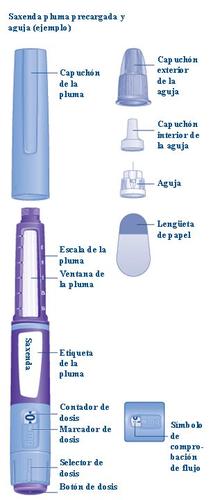
1 Подготовка ручки с новой иглой
- Проверьте название и цвет этикеткина вашей ручке, чтобы убедиться, что она содержит Саксенду. Это особенно важно, если вы используете более одного типа инъекционного лекарства. Использование неправильного лекарства может быть вредным для вашего здоровья.
- Удалите колпачок с ручки.

- Проверьте, что раствор в ручке имеет прозрачныйи бесцветный вид. Посмотрите через окно ручки. Если раствор имеет мутный вид, не используйте ручку.
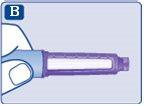
- Возьмите новую иглуи удалите бумажную ленту.
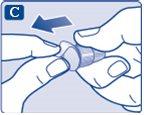
Убедитесь, что игла вставлена правильно.
- Поместите иглу прямо в ручку.
- Завинтите ее до упора.
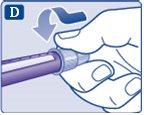
Игла покрыта двумя колпачками. Вы должны удалить оба колпачка.Если вы забудете удалить оба колпачка, вы можете неввести никакого раствора.
- Удалите внешний колпачок иглы и сохраните его для дальнейшего использования.Вам он понадобится после инъекции, чтобы безопасно удалить иглу из ручки.
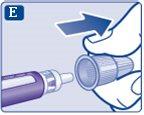
- Удалите внутренний колпачок иглы и выбросьте его.Если вы попытаетесь снова надеть его, вы можете случайно уколоться иглой.
На кончике иглы может появиться капля раствора. Это нормально, но все равно необходимо проверить поток, если вы используете новую ручку впервые.
Не ставьте новую иглуна ручку, пока не будете готовы сделать инъекцию.
Всегда используйте новую иглудля каждой инъекции.
Таким образом, вы можете избежать засоров игл, загрязнений, инфекций и неточных дозировок.
- Никогда не используйте согнутые или поврежденные иглы.
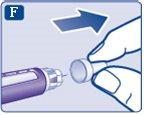
2 Проверка потока с каждой новой ручкой
- Если ваша ручка уже используется, перейдите к шагу 3 «Выбор дозы». Проверяйте поток только перед первой инъекцией с каждой новой ручкой.
- Поверните селектор дозы к символу проверки потока ()сразу после 0. Убедитесь, что символ проверки потока совпадает с маркером дозы.
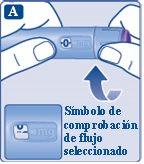
- Держите ручку с иглой, направленной вверх.
Нажмите и удерживайте кнопку дозыдо тех пор, пока счетчик дозы не вернется к 0. 0 должен совпадать с маркером дозы.
На кончике иглы должна появиться капля раствора.
Может остаться небольшая капля на кончике иглы, но она не будет введена.
Если не появляется никакая капля, повторите шаг 2 «Проверка потока с каждой новой ручкой» до 6 раз. Если капля все равно не появляется, замените иглу и повторите шаг 2 «Проверка потока с каждой новой ручкой» еще раз.
Если, несмотря на все усилия, не появляется капля,выбросьте ручку и используйте новую.
Всегда убедитесь, что появляется капляна кончике иглы перед использованием новой ручки впервые. Таким образом, вы можете убедиться, что раствор течет.
Если не появляется капля, небудет введено лекарство, даже если счетчик дозы будет двигаться. Это может указывать на то, что игла заблокирована или повреждена.
Если вы не проверите поток перед первой инъекцией с каждой новой ручкой, возможно, что не будет введена назначенная доза, и Саксенда не произведет ожидаемого эффекта.
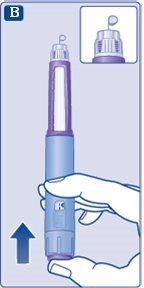
3 Выбор дозы
- Поверните селектор дозы до тех пор, пока не появится доза на счетчике дозы (0,6мг, 1,2мг, 1,8мг, 2,4мг или 3,0мг).
Если вы выбрали неправильную дозу, вы можете повернуть селектор дозы вперед или назад, чтобы выбрать правильную дозу.
Ручка может выбрать до максимальной дозы 3,0 мг.
Селектор дозы меняет дозу. Только счетчик дозы и маркер дозы показывают, сколько мг вы выбрали для каждого введения.
Вы можете выбрать до 3,0 мг за дозу. Когда в ручке остается менее 3,0 мг, счетчик дозы останавливается до того, как появится 3,0.
Селектор дозы щелкает по-разному, когда вы поворачиваете его вперед, назад или превышаете количество мг, оставшихся в ручке. Не считайте щелчки ручки.
Прежде чем вводить лекарство, всегда используйте счетчик дозы и маркер дозы, чтобы увидеть, сколько мг вы выбрали.
Не считайте щелчки ручки.
Не используйте шкалу ручки, поскольку она показывает только приблизительное количество раствора, оставшегося в ручке.
С помощью селектора дозы должны выбираться только дозы 0,6мг, 1,2мг, 1,8мг, 2,4мг или 3,0мг.Выбранная доза должна быть точно совпадать с маркером дозы, чтобы обеспечить введение правильной дозы.
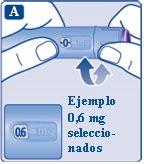
Сколько раствора осталось?
- Шкала ручки показывает приблизительноеколичество раствора, оставшегося в ручке.
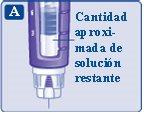
- Чтобы узнать, сколько раствора осталось точно,используйте счетчик дозы:
Поверните селектор дозы до тех пор, пока счетчик дозы не остановится.
Если он показывает 3,0, это означает, что в ручке осталось не менее 3,0мг. Если счетчик дозы останавливается до 3,0мг, это означает, что в ручке не достаточно раствора для полной дозы 3,0 мг.
Если вам нужно больше лекарства, чем осталось в ручке
Если ваш врач или медсестра посоветовали вам это и научили, как это делать, вы можете разделить дозу между ручкой в использовании и новой. Используйте калькулятор, чтобы спланировать дозу согласно указаниям вашего врача или медсестры.
Будьте очень осторожны, чтобы сделать расчет правильно.
Если вы не уверены, как разделить дозу, используя две ручки, выберите и введите дозу, которую вам нужно, с помощью новой ручки.
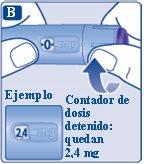
4 Введение дозы
- Вставьте иглу под кожутак, как вам научил ваш врач или медсестра.
- Проверьте, что вы можете видеть счетчик дозы.Не закрывайте его пальцами. Это может прервать инъекцию.
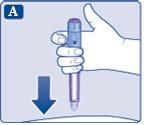
- Нажмите и удерживайте кнопку дозы. Обратите внимание, что счетчик дозы возвращается к 0.0 должен совпадать с маркером дозы. Вы можете услышать или почувствовать щелчок.
- Продолжайте нажимать кнопку дозы, пока держите иглу в коже.
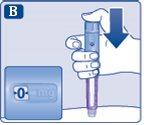
- Посчитайте медленно до 6, пока держите кнопку дозы нажатой.
- Если вы удалите иглу раньше, вы можете увидеть, как раствор вытекает из кончика иглы. Это означает, что не была введена полная доза.
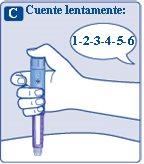
- Удалите иглу из кожи.Вы можете отпустить кнопку дозы.
Если появляется кровь в месте инъекции, слегка надавите.
Может появиться капля раствора на кончике иглы после инъекции. Это нормально и не влияет на дозу.
Всегда проверяйте счетчик дозы, чтобы знать, сколько мг вы вводите.Нажмите и удерживайте кнопку дозы до тех пор, пока счетчик дозы не покажет 0.
Как обнаружить, если игла заблокирована или повреждена?
- Если счетчик дозы не показывает 0 после непрерывного нажатия кнопки дозы, возможно, вы использовали заблокированную или поврежденную иглу.
- В этом случае небыло введено никакоголекарства, даже если счетчик дозы двигался от исходной дозы, которую вы выбрали.
Что делать, если игла заблокирована?
Замените иглу, как описано в шаге 5 «После инъекции», и повторите все шаги, начиная с шага 1 «Подготовка ручки с новой иглой». Убедитесь, что вы выбрали полную дозу, которую вам нужно.
Никогда не трогайте счетчик дозы, пока вводите лекарство.Это может прервать инъекцию.
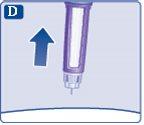
5 После инъекции
- Всегда выбрасывайте иглу после каждой инъекции, чтобы обеспечить правильное введение и избежать засоров игл. Если игла засорена, небудет введено лекарство.
- Вставьте кончик иглы в ее внешний колпачок,положенный на плоскую поверхность, не трогая иглу и внешний колпачок иглы.
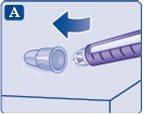
- Когда игла будет покрыта, полностью и осторожно нажмите внешний колпачок.
- Отвинтите иглуи выбросьте ее осторожно, следуя инструкциям вашего врача, медсестры, фармацевта или местных властей.
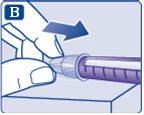
- Поместите колпачок наручку после каждого использования, чтобы защитить раствор от света.
Когда ручка будет пуста, выбросьте ее безиглы, следуя инструкциям вашего врача, медсестры, фармацевта или местных властей.
Никогда не пытайтесь снова надеть внутренний колпачок иглы.Вы можете уколоться ею.
Всегда удаляйте иглу из ручки после каждой инъекции.
Таким образом, вы можете избежать засоров игл, загрязнений, инфекций, потерь раствора и неточных дозировок.
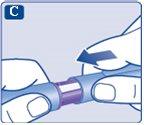
Дополнительная важная информация
- Всегда держите ручку и иглы вне поля зрения и досягаемости других людей, особенно детей.
- Никогда не делитесьручкой или иглами с другими людьми.
- Лица, ухаживающие за пациентами, должны быть очень осторожны при обращении с использованными иглами, чтобы избежать случайных уколов и инфекций.
- Меняйте место инъекции каждый день, чтобы уменьшить риск развития бугров под кожей.
Уход за ручкой
- Не оставляйте ручку в машинеили в другом месте, где она может перегреться или переохладиться.
- Не вводите Саксенду, если она была заморожена.Если вы это сделаете, вы не получите ожидаемого эффекта от этого лекарства.
- Не подвергайте ручку воздействию пыли, грязи или жидкостей.
- Не мойте, не замачивайте и не смазывайте ручку.Ее можно протереть влажной тканью с мягким мылом.
- Убедитесь, что ручкане упадети не ударится о твердые поверхности. Если ручка упала или вы подозреваете, что она может иметь проблему, поместите новую иглу и проверьте поток перед инъекцией.
- Не пытайтесь заполнить ручку повторно.Как только она будет пуста, ее необходимо выбросить.
- Не пытайтесь ремонтировать ручкуили разбирать ее.
- Страна регистрации
- Наличие в аптекахПроблемы с поставками
- Активное вещество
- Требуется рецептДа
- Производитель
- Информация носит справочный характер и не является медицинской рекомендацией. Перед приемом любых препаратов проконсультируйтесь с врачом. Oladoctor не несет ответственности за медицинские решения, принятые на основе этого контента.
- Аналоги САКСЕНДА 6 мг/мл раствор для инъекций в предварительно заполненной ручке-шприцеФорма выпуска: ИНЪЕКЦИОННЫЙ РАСТВОР, 6 мг/млАктивное вещество: ЛираглютидПроизводитель: Sun Pharmaceutical Industries (Europe) B.V.Требуется рецептФорма выпуска: ИНЪЕКЦИОННЫЙ РАСТВОР, 6 мг/млАктивное вещество: ЛираглютидПроизводитель: Sun Pharmaceutical Industries (Europe) B.V.Требуется рецептФорма выпуска: ИНЪЕКЦИОННЫЙ РАСТВОР, 6 мг/млАктивное вещество: ЛираглютидПроизводитель: Zentiva K.S.Требуется рецепт
Аналоги САКСЕНДА 6 мг/мл раствор для инъекций в предварительно заполненной ручке-шприце в других странах
Лучшие аналоги с тем же действующим веществом и терапевтическим эффектом.
Аналог САКСЕНДА 6 мг/мл раствор для инъекций в предварительно заполненной ручке-шприце в Польща
Аналог САКСЕНДА 6 мг/мл раствор для инъекций в предварительно заполненной ручке-шприце в Україна
Врачи онлайн по САКСЕНДА 6 мг/мл раствор для инъекций в предварительно заполненной ручке-шприце
Консультация по дозировке, побочным эффектам, взаимодействиям, противопоказаниям и продлению рецепта на САКСЕНДА 6 мг/мл раствор для инъекций в предварительно заполненной ручке-шприце – по решению врача и с учетом местных правил.











